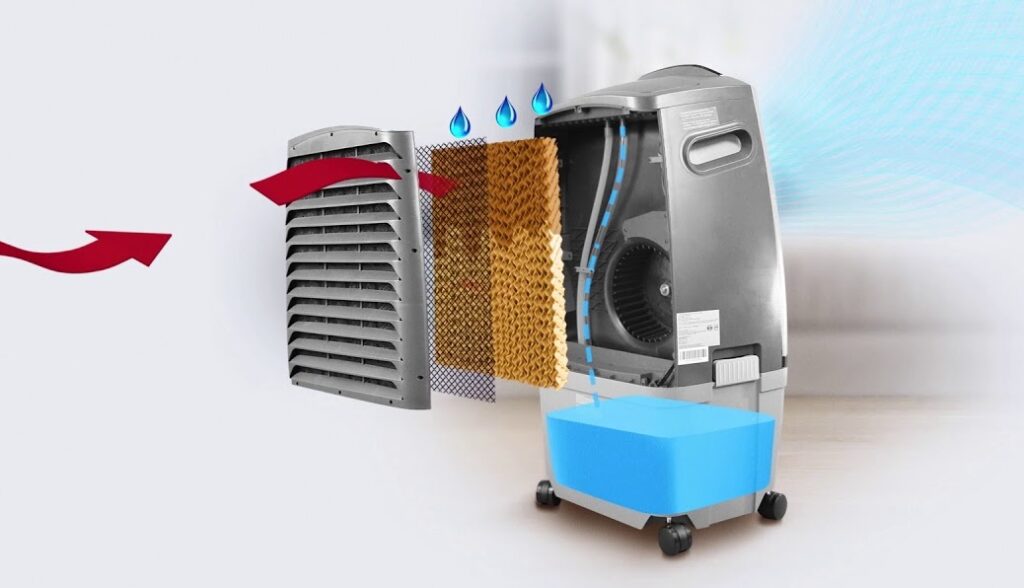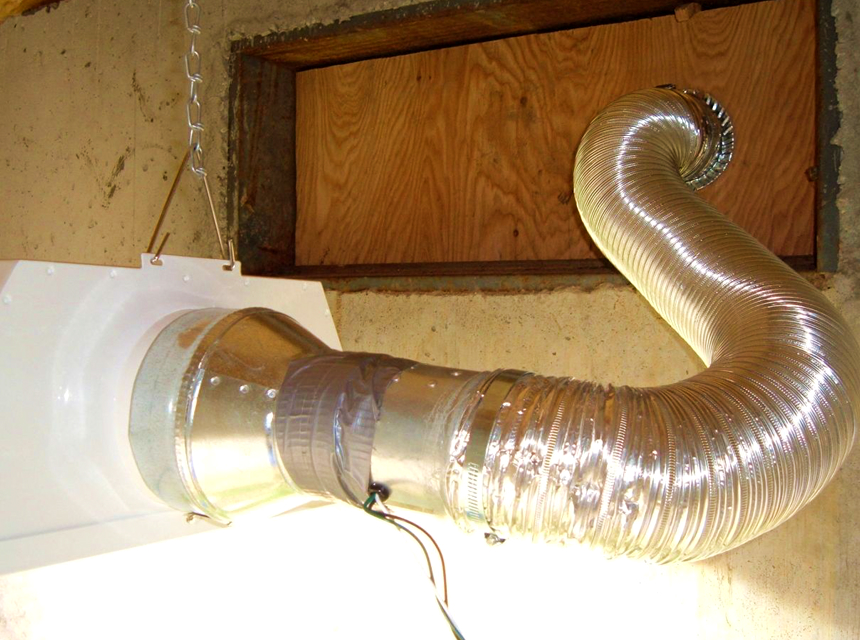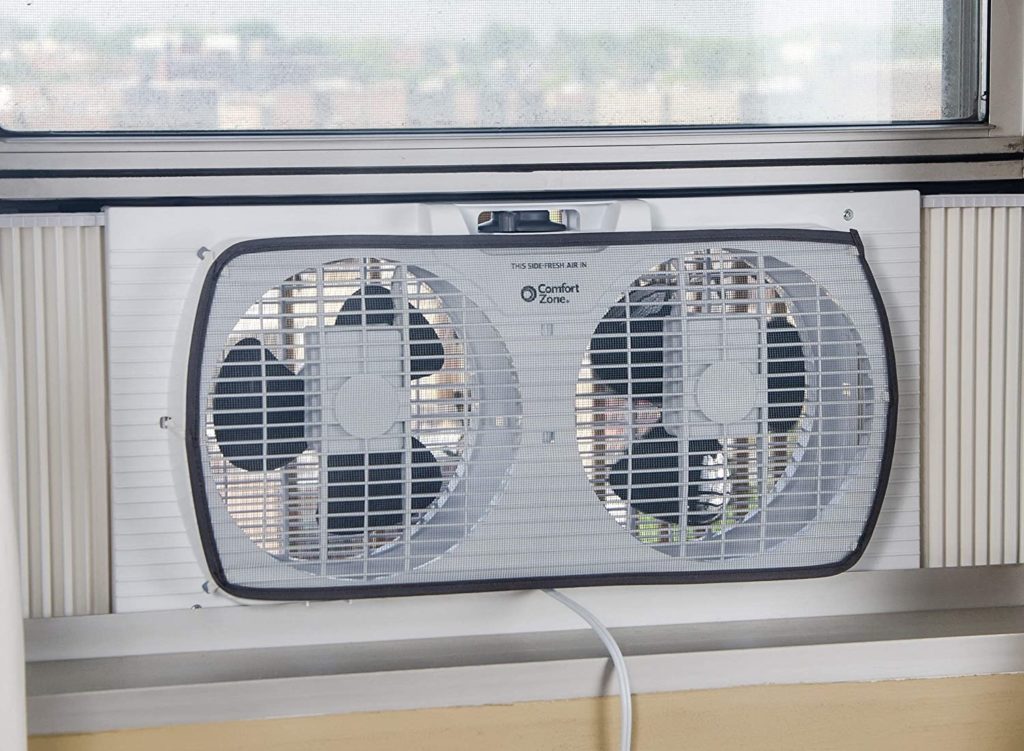

Ceiling fans are a do-it-all fixture that can add to the ambiance and comfort of any room. But selecting one based on how it looks would be a huge mistake. With so many products available on the market, how do you know that a particular one you choose will actually do a great job of moving the air in your room?
In this guide, we closely look at eight fans that were highly rated by both our team and the people who bought and used them and focus on the features that make the best ceiling fan. Aside from the size of the fan and its speed, since this affects how much air it will move around a room, we checked if there’s a reversible operation available to use it equally effectively in summer and winter. You’ll also need to choose a fan based on whether you plan to install it inside or outside, so we included both types. And last but not least, it’s important that your ceiling fan fits with the aesthetic of your home and doesn’t present an eyesore, so we picked different designs and color varieties. We believe that the Westinghouse Lighting Comet is a perfect fan and award it our Editor’s Choice nomination.
More features: for large rooms up to 225 sq ft, reversible blades, frosted glass
Our Editor’s Choice ceiling fan from Westinghouse Lighting is inexpensive, stylish, and effective. The fan comes in a standard 52-inch size and offers 3,589 CFM to move air through rooms up to 225 square feet. That means that it’s suitable for large kitchens and living rooms as well as smaller bedrooms.
What users liked best about this fan is the integrated light. The light contains two 40-watt lightbulbs. Plus, the contrast between the frosted glass over and the dark matte of the fan itself provides a beautiful, modern aesthetic that fits with almost any home.
Despite having five blades, users found that this fan was very quiet. The blades aren’t all that angled, which is partially why this fan doesn’t offer more air movement for its size. In fact, the biggest issue that users had with this fan was that it doesn’t provide more airflow for its size. The fan also has a reverse operation, which allows it to be used equally well in winter as well as in summer.
One downside to this fan is that while a remote control is available, it’s not included with the fan. If you’re putting the fan in a room with high ceilings, users highly recommend purchasing the remote and adding the remote control kit at the time of installation.
Westinghouse provides a limited lifetime warranty on the motor and a two-year warranty on the remaining components.
More features: 13-degree blade pitch, WhisperWind motor and reversible blades
The Sentinel fan from Hunter is a relatively standard indoor ceiling fan. It’s inexpensive price point, high maximum airflow, and clean, modern aesthetic make it a favorite among homeowners.
This fan is rated up to more than 5,000 CFM thanks to its simple three-blade design and 13-degree blade pitch. That design reduces drag on the WhisperWind motor, allowing it to operate silently and efficiently. In fact, users were extremely impressed by how quiet this fan is even when it’s running at maximum speed.
The fan comes with a pair of dimmable lights inside a frosted glass cover, which allows you to closely control the lighting inside your room. A remote control is included with the fan and it can be easily mounted to your wall next to your ceiling light switches. The remote also allows you to reverse the blades for winter operation and to switch between the fan’s three speed settings.
The only thing that users wished for with this fan were more color options. Currently, Hunter only makes the Sentinel in nickel and bronze. While these colors match with a variety of room aesthetics, this fan is so useful and inexpensive that users wanted to match it with every room of their home.
On top of all the features this fan comes with, Hunter offers a limited lifetime warranty on the motor. That said, users didn’t experience any problems with this fan after several years of use, and many returned to buy a second model.
More features: dimmable LED light, 48-degree blade pitch, Energy Star Certified and ADA Compliant
The Minka-Aire Light Wave is one of the most impressive indoor ceiling fans on the market today, although you can expect to pay a premium for all of the features it comes with. This modern-looking fan has uniquely designed blades with a 48-degree pitch. That allows it to move a whopping 4,400 CFM of air around while using extremely little electricity. In fact, this is one of only two fans that we reviewed that has received an Energy Star rating.
Users commonly complained that this fan creates a loud humming noise, which is very problematic given its high cost. However, this humming appears to go away within the first few days of using the fan – so, simply plan on a break-in period after installing the fan.
The light on the underside of the fan is an energy-efficient LED, and it can be easily dimmed using the included remote control. It’s bright, especially with the white cover over it, so you’ll probably want to take advantage of the dimmer. In addition, the fan can operate at three different speeds so you can control the breeze inside your home. Unfortunately, if you want to reverse the blade operation, you’ll need to manually toggle a switch on the motor.
The fan comes with a six-inch downrod for installation, although Minka-Aire offers a variety of longer downrods as well. You also get a lifetime warranty on the motor and all parts, which is nice considering the high price of this fan.
More features: WhisperWind motor, ETL Damp rated, blade finish reminiscent of aged beach wood
This indoor/outdoor fan from Hunter offers a huge amount of airflow with its five angled blades. While adding only two inches to the standard 52-inch blade length, the wide blades are rated to 6,239 CFM at full speed. The fan can be set to run at three different speeds, and it’s even reversible for use during the winter if you mount the fan inside your home.
The WhisperWind motor was a major attraction of this fan for users, since it really is almost silent when running at low and medium speeds. Users noted a slight hum at high speeds, but it was hardly something to worry about. They also loved the aesthetic of this fan, which includes a blade finish that mimics the look of aged wood and a weathered zinc finish over the motor housing. The cylindrical light fixture can be a bit much for some minimalist, modern homes, but it looks great when mounted over an enclosed patio.
The lighting uses two CFL bulbs, which are very efficient but do take a few minutes to warm up to full brightness. This can be an advantage for outdoor use, but inside many users wished that the light would simply turn up to the intended brightness immediately.
For outdoor use, the fan is designed to be safe in windy and damp conditions – so high humidity isn’t a problem, although you’ll want to keep the fan protected from rain. Hunter offers a limited lifetime warranty on the motor, but no warranty on the rest of the fan’s parts.
More features: 3 lights, WhisperWind motor, patented Dust Armor nanotechnology to repel dust build-up
This budget-friendly indoor ceiling fan from Hunter is a great choice for any room. It features a pretty standard aesthetic, with a trio of lights underneath the fan motor. However, it’s only available in either white or bronze, so your choices for matching colors are more limited than with other ceiling fans.
The fan provides a surprising amount of air movement given its inexpensive price point. Rated for over 5,000 CFM, this fan works equally well in a large living room as in a smaller bedroom. Plus, users loved that the WhisperWind motor is almost silent, even when operating at full power.
The fan is designed with three operating speeds, and the blades can be run in reverse to distribute heat around your room during the winter months. However, the three 60-watt lightbulbs are either on or off – there is no dimmer function built into this fan.
It’s also worth noting that while this fan is compatible with a Hunter universal remote control, it doesn’t come with a remote. If you choose not to get the remote control, you can use the pull-cords to adjust the fan and light settings.
Other than that, users had almost no complaints about this simple fan. The package comes with everything you need for installation, including lightbulbs, a downrod, and a sloped ceiling mounting kit. Combined with the limited lifetime warranty on the motor and parts, that makes this fan one of the most attractive values on the market.
More features: suitable for damp locations, opal frosted glass, oil rubbed bronze finish, 3 speeds, remote control
In addition to a large air displacement of 5,009 cfm, this 52 “(132.08 cm) diameter Casa Breeze fan also offers you the beauty and charm of the islands. Its powerful, yet quiet motor has 3 speeds and propels the 5 plastic blades. The fan comes with a lifetime warranty on the motor and a one-year warranty on the other components.
This fan is ideal for humid places where a lot of air circulation is required. The light is generated using two 60 W A15 bulbs and provides a welcoming atmosphere thanks to its globe Amber. The unit can be installed with or without the 4-inch rod on a ceiling at or at a maximum tilt of 12 degrees. This package also includes a remote control to easily select the desired speed. The materials of construction include metal, glass, and plastic and come in a bronze color and oil-rubbed bronze blade.
The package includes a 4-inch shank remote control that helps you take control of the device in the comfort of your chair or bed. However, it’s not a multidimensional fan. The type of lighting on this fan is incandescent and you can use it indoors, especially in damp places.
More features: 14-degree blade pitch, cap for non-light use included, ETL Listed
This compact fan from Minka-Aire pushes around far more air than you’d expect it to. With blades that are just 44 inches in length, this fan is rated for a higher airflow CFM than many standard 52-inch fans. The secret is in the design of the blades, which are constructed with a 14-degree pitch and optimized for air movement without dragging the motor or producing a lot of noise.
Unfortunately, this impressive design doesn’t come cheap. This ceiling fan is by far the most expensive that we reviewed, at over $300. What we can say for Minka-Aire is that they do include a six-inch downrod (longer downrods are available for purchase) as well as the remote control for this fan as part of that price. In addition, the compact design makes this one of the more energy efficient fans that we reviewed.
The fan is equipped with three speed settings as well as reverse operation for winter use. In addition, the integrated LED lights are dimmable so you have complete control over the brightness of your room. All of these settings are easily controlled with the remote, which can also be mounted to your wall.
The aesthetic of the Concept II is relatively unassuming. Some users didn’t love the shininess of the white finish, but there are five colors available so that you can easily match the fan to any room.
The biggest complaint that we had with this fan is that it only comes with a one-year warranty. Considering the high price, this is pretty surprising and disappointing.
More features: 4-speed fan, Energy Star approved
This modern and highly efficient ceiling fan from Emerson is ideal for rooms where you need a lot of air movement. The fan is equipped with three airfoil style blades, which are highly angled and lightweight so that they don’t put much drag on the motor. The blades are also larger than on most of the other fans we reviewed, at 60 inches long. As a result, this fan is able to move an impressive amount of air around a room – it’s rated for 6,916 CFM.
Thankfully, you don’t have to move all that air every time you turn on the fan. It comes with four speed settings, so you can choose to keep the fan running all the time at a low speed to help your air conditioner work more efficiently. The speed settings are controlled by a wall receiver, which needs to be installed at the same time as the fan.
Users loved that this fan is almost silent when operating at lower speeds, and remains quiet when operating at full speeds. However, they did wish that it came with a more convenient reversible switch – right now, it’s located on top of the fan.
Emerson provides a limited lifetime warranty on the fan motor and a one-year warranty on all other parts. Note that the company recommends avoiding this fan if you live in a humid, wet environment, since the brushed steel blades can rust if they get wet.
Now that you’ve learned more about our eight favorite ceiling fans, how do you decide which one is best for you? Ceiling fans are designed to last almost as long as your home, so it’s important to get one that you’ll be happy with for years to come. In our buying guide, we’ll cover everything you need to know about ceiling fans – from why you should get one to what features you should look for.
The number one reason to invest in a ceiling fan is that it helps move air around a room. That airflow can help keep you cool, or it can simply help move fresh air from a window into your room to eliminate that feeling of living with stale air.
Ceiling fans use far less energy than air conditioners and HVAC systems, so they’re also a much more economical option than these systems. Importantly, if you use a ceiling fan in conjunction with an air conditioning or heating system, you’ll be able to run the AC or heat for a shorter period of time and still get that cold or hot air throughout the entire room.
So, having a ceiling fan is a great idea even if – and really, especially if – you already have an HVAC system.
On top of that, many ceiling fans come with lights. These lights can supplement the ceiling lights you already have in your home to provide extra light, or you can use the light in your ceiling fan on its own as a way to save energy and create a dimmer ambiance.
Operating a ceiling fan is extremely simple, and many come with remote controls or built-in switches in your wall. As a result, there’s no reason not to take advantage of the many benefits that the best ceiling fan can offer.
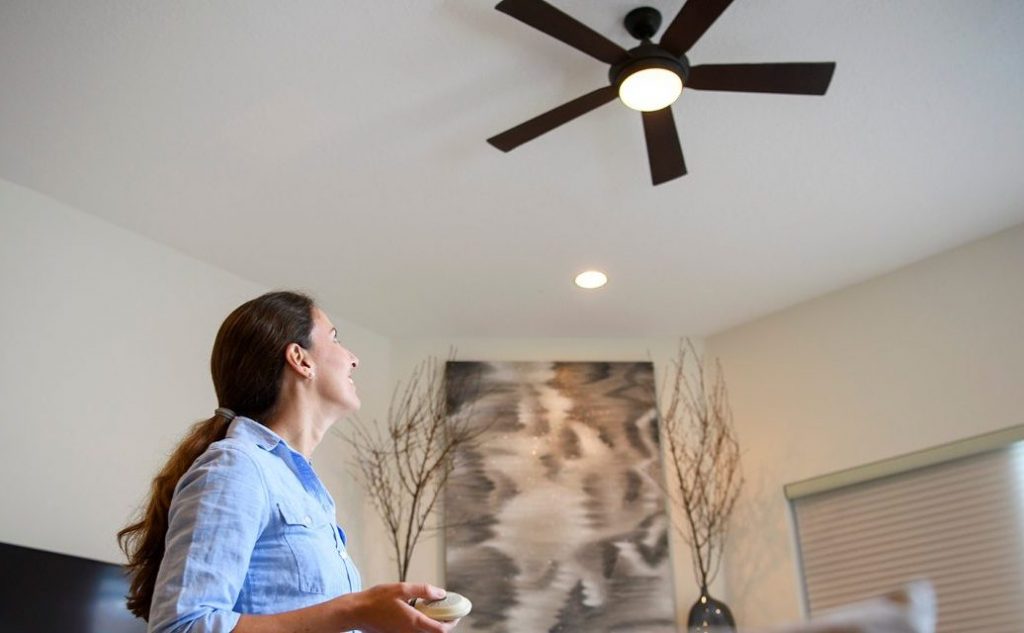
The majority of ceiling fans are designed for indoor use, since that’s where you’re probably spending most of your time and could most use the benefits of circulating air from your AC or heating systems. However, some people like to add a ceiling fan to an enclosed outdoor porch as a way to move air around that space or add overhead lighting.
In that case, you’ll need a ceiling fan that is specifically designed for outdoor installation, like the Westinghouse Lighting Great Falls or the Hunter Key Biscayne fans. These fans are designed so that the electrical wiring is protected from the elements, and they’re able to rotate freely when blown around by the wind.
One of the first things to consider when choosing a ceiling fan is how large it needs to be. Ceiling fans come in a wide variety of sizes, with larger fans offering more volume of circulated air in exchange for taking up more space and using more energy.
The size of a fan is typically measured in blade diameter or blade sweep, which is the distance from the center of the fan to the end of the blade. The majority of ceiling fans are designed with blades around 52 inches in length, which is suitable for a standard 10’ by 10’ room or slightly larger. However, keep in mind that you may need a larger fan, like the 60-inch Emerson fan, for a larger living room or foyer. If space is limited, the smaller 44-inch Minka-Aire fan may be a better choice for your home.
It’s also important to think about the number of fan blades. Fans with fewer blades create less drag on the motor, which allows them to move air more efficiently. So, fans with three blades rather than four or five tend to create a greater wind chill effect. In addition, fans with fewer blades tend to be quieter because there is less drag on the motor.
But, it’s a good idea to look at performance and efficiency metrics rather than decide on a fan solely based on the number of blades it has since manufacturers shape their blades differently.
Ideally, ceiling fan blades should be shaped so that they have a pitch of at least 14 degrees. Less than this, and they simply slice through the air rather than push air around. However, as the blade pitch increases, so will drag on the motor and the amount of noise produced by your fan.
Performance, measured in terms of cubic feet of air moved per minute (CFM), can vary dramatically among ceiling fans even if they are the same size and have the same number of blades. That’s because the motor and blade design can vary quite a bit. For example, the Minka-Air Light Wave moves a lot more air per minute than the Minka-Aire Concept II, even though they both have three blades, because the Light Wave has a stronger motor and more curvature to its blades.
Of course, a larger motor means that your ceiling fan will take up more energy. So, it’s important to look at efficiency when searching for a ceiling fan as well. Ceiling fan efficiency is typically measured in CFM per watt. Unfortunately, this information can be difficult to find without thorough testing, so a good substitute to look for is an Energy Star rating. Energy Star-rated ceiling fans, like the Minka-Aire Light Wave and Emerson fans, are given that certification based on their electrical efficiency.
If you’re installing a ceiling fan in your home, it’s definitely worth considering whether or not you need a light bulb on it. Typically, adding a light to your ceiling fan will make it more expensive than the same fan without a light. However, keep in mind that you don’t have to turn on the light even if it’s there – instead, you can have the option of a light when you want it, but you don’t need to turn the light on when the fan is running. Because of this, all of the ceiling fans that we reviewed except the Emerson Loft fan come with a light.
When looking at lights, there is a lot to think about. Some fans like the Minka-Aire Light Wave offer dimmable lights, which are perfect if the existing ceiling lights in your room aren’t on a dimmer. Other fans, like the Hunter Builder Plus, have multiple lights so that you can change the brightness in your room as needed. Look for nice features like frosted glass, found on the Editor’s Choice Westinghouse Lighting Comet fan, that give your ceiling fan lights a brighter and more natural tint.
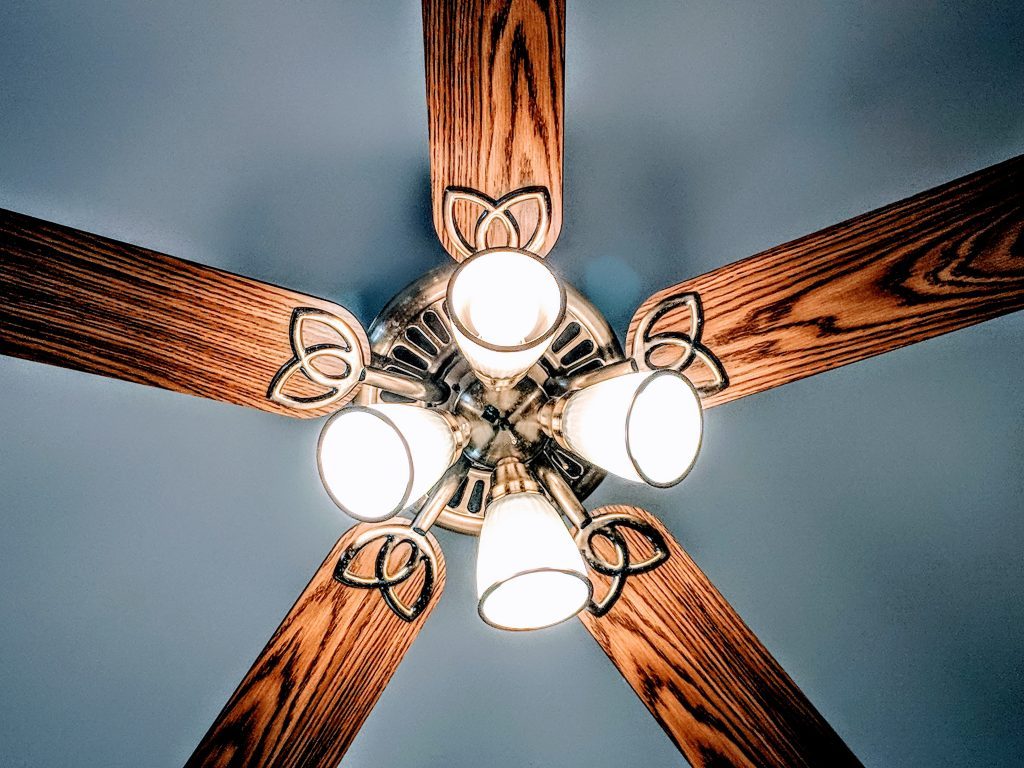 Warranty
WarrantyCeiling fans are designed to last for years as a fixture in your home and they can be a significant investment. So, it’s always a good idea to look for warranties so you know that your protected in case the motor unexpectedly dies or something else goes wrong. All of the fans we reviewed except the Minka-Aire Concept II come with a limited lifetime warranty on the motor, which is extremely important. Many fans also offer a lifetime warranty on the rest of the parts, while others limit the warranty to just a few years on the rest of the fan components.
While having a warranty is important as a last resort, you can protect yourself and your home from the beginning by choosing a ceiling fan from a reputable brand. If you’re trying to save money by buying a cheap, budget fan from a big box store, chances are you’ll end up spending more to repair and replace that fan in a few years’ time. Specifically, avoid cheap fans from companies like Hampton Bay and Harbor Breeze – they may be inexpensive, but they lack lifetime warranties and are known to fail frequently.
Instead, look for fans from companies like Minka-Aire, Westinghouse Lighting, and Emerson. You’ll find that all of the ceiling fans that we reviewed are made by brands known for producing reliable fan and lighting fixtures. The lifetime warranties are just further proof of this reliability.
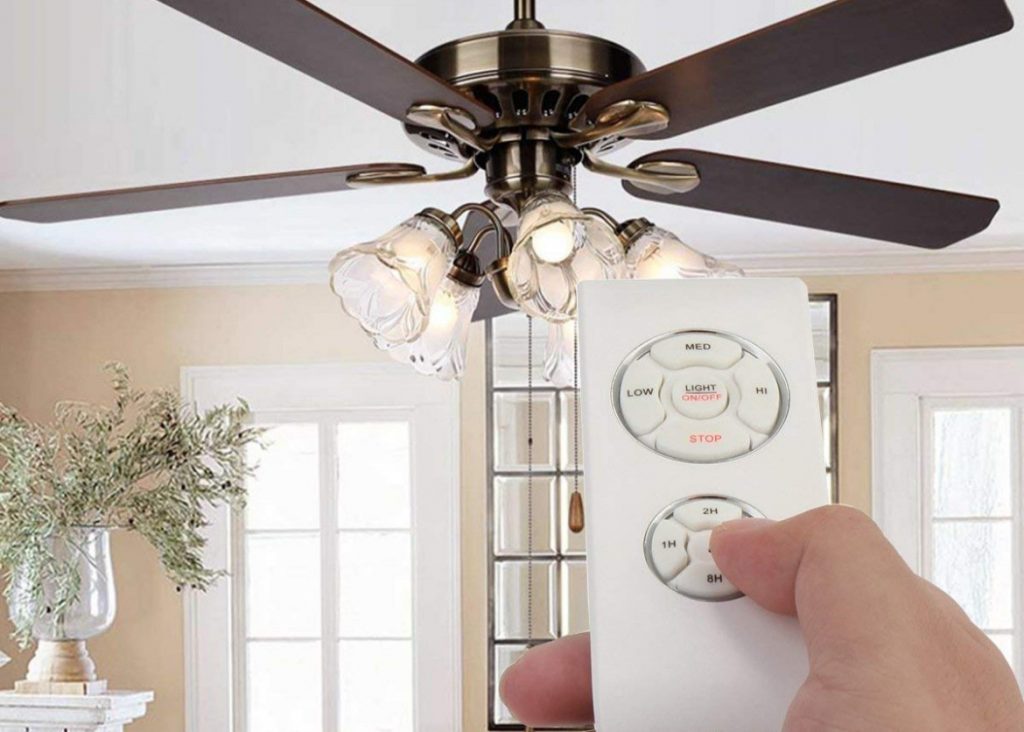
On top of that, you need to think about how you plan to control your fan. Many modern ceiling fans are supplied with a remote control that lets you easily access all of their operations. In many cases, it’s easy to mount this remote control to a wall next to the switches for your ceiling lights. However, not every fan comes with a remote control, and some, like the Hunter Builder Plus and Hunter Key Biscayne, have pull cords that you can use to activate the fan and lights.
Finally, think about whether your fan comes with a downrod or if one can be added later. Downrods are simply mounting rods that connect your fan to the ceiling, and they’re essential if you plan to put your fan in a room with high ceilings. Without a downrod, your fan will be too high for you to notice the air being moved and it won’t work as efficiently.
Most of the fans we reviewed come with downrod mounting kits, but it’s important to double-check whether the downrod is long enough for your needs if you’re looking for a fan to put in a high-ceilinged room.
Ceiling fans vary widely in cost, but in general you can expect to spend between $100 and $200 for a high-quality indoor ceiling fan. Our Editor’s Choice Westinghouse Lighting Comet is priced at just $104. However, manufactures like Minka-Aire charge a premium for their ceiling fans – the Light Wave is priced at a $280 and the Concept II is priced at $320. However, most of the ceiling fans we reviewed fall below $200, and many are less than $150.
Our three overall favorite ceiling fans on the market today are the Westinghouse Lighting Comet, the Hunter Sentinel, and the Minka-Aire Light Wave. The Minka-Aire Light Wave is a great indoor ceiling fan for those who want style and functionality. It comes with unique blades and an impressive 4,400 CFM of air movement, making it perfect for larger rooms. The Hunter Sentinel is beloved by homeowners. It’s relatively inexpensive and offers all of the features you could want in a ceiling fan, from multiple speeds and reversible operation to dimmable LED lights. We feel that the Westinghouse Lighting Comet is the overall best ceiling fan on the market today thanks to its high efficiency, beautiful aesthetic, and low price. We were particularly impressed with the design of the frosted glass light, which makes this fan a perfect addition to any room in your home.

